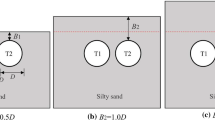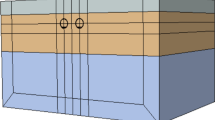Abstract
The intersection structure, composed of twin shield tunnels and a transverse passage, is ubiquitous in the metros around the world. However, the dynamic characteristics of this kind of intersection structure have not been studied a lot yet. By carrying out the corresponding model tests and numerical simulations, the dynamic characteristics of this kind of intersection structure are studied in this paper, which is very helpful for the determination of the ground vibration from this kind of underground structure. The results show that the vibration of the transverse passage is more severe than the main tunnel, manifested that the frequency response function (FRF) of the transverse passage has greater magnitudes than that of the main tunnel at the locations with the same distance from the vibration source. The peak frequencies of the acceleration responses at different locations of the intersection structure under the moving train load are all located in the frequency band 44.9–56.1 Hz where the corresponding 1/3 octave band spectra of FRF have the largest values in the considered frequency band 31.5–250 Hz, indicating that the natural frequencies of the intersection structure in the frequency band 44.9~56.1 Hz have significant influences on its acceleration responses below 250 Hz induced by the moving train.
Similar content being viewed by others
References
Beijing Planning Commission (2013). Code for design of metro, Beijing Construction Industry Press, Beijing, China, pp. 259–260.
Bian, X. C. (2005). Dynamic response analysis of foundation and tunnel under motion load of high speed train, PhD Thesis, Zhejiang University, Zhejiang, China.
Cai, X. P., Li, D. C., Zhang, Y. R., Miao, Q., and Cui, R. X. (2018). “Experimental study on the vibration control effect of long elastic sleeper track in subways.” Shock and Vibration, Vol. 2018, pp. 1–13, DOI: https://doi.org/10.1155/2018/6209518.
Di, H., Zhou, S., Luo, Z., He, C., Xiao, J., and Li, X. (2017). “A vehicle-track-tunnel-soil model for evaluating the dynamic response of a double-line metro tunnel in a poroelastic half-space.” Computers and Geotechnics, Vol. 101, pp. 245–263, DOI: https://doi.org/10.1016/j.compgeo.2017.12.003.
Feng, S. J., Zhang, X. L., Wang, L., Zheng, Q. T., Du, F. L., and Wang, Z. L. (2017). “In situ experimental study on high speed train induced ground vibrations with the ballast-less track.” Soil Dynamics and Earthquake Engineering, Vol. 102, pp. 195–214, DOI: https://doi.org/10.1016/j.soildyn.2017.09.001.
Gupta, S., Degrande, G., and Lombaert, G. (2009). “Experimental validation of a numerical model for subway induced vibrations.” Journal of Sound and Vibration, Vol. 321, Nos. 3–5, pp. 786–812, DOI: https://doi.org/10.1016/j.jsv.2008.10.014.
He, C., Feng, K., and Yang, X. (2007). “Similar model test study on lining structure of super-large section segment of Nanjing Yangtze River Tunnel.” Journal of Rock Mechanics and Geotechnical Engineering, Vol. 26 No. 11, pp. 2260–2269, DOI: https://doi.org/10.3321/j.issn:1000-6915.2007.11.012.
He, C., Zhou, S., Guo, P., Di, H., and Zhang, X. (2018). “Analytical model for vibration prediction of two parallel tunnels in a full-space.” Journal of Sound and Vibration, Vol. 423, pp. 306–321, DOI: https://doi.org/10.1016/j.jsv.2018.02.050.
Huang, J., Yuan, T., Peng, L., Yu, J., and Ding, Z. (2015). “Model test on dynamic characteristics of invert and foundation soils of high-speed railway tunnel.” Earthquake Engineering and Engineering Vibration, Vol. 14, No. 3, pp. 549–559, DOI: https://doi.org/10.1007/s11803-015-0044-z.
Iai, S. (1989). “Similitude for shaking table tests on soil-structure-fluid model in 1g gravitational field.” Soils and Foundations, Vol. 29, No. 1, pp. 105–118, DOI: https://doi.org/10.3208/sandf1972.29.105.
Iai, S., Tobita, T., and Nakahara, T. (2005). “Generalised scaling relations for dynamic centrifuge tests.” Geotechnique, Vol. 55, No. 5, pp. 355–362, DOI: https://doi.org/10.1680/geot.55.5.355.66019.
Kuo, K. A., Hunt, H. E. M., and Hussein, M. F. M. (2011). “The effect of a twin tunnel on the propagation of ground-borne vibration from an underground railway.” Journal of Sound & Vibration, Vol. 330, No. 25, pp. 6203–6222, DOI: https://doi.org/10.1016/j.jsv.2011.07.035.
Kuo, K. A., Verbraken, H., Degrande, G., and Lombaert, G. (2016). “Hybrid predictions of railway induced ground vibration using a combination of experimental measurements and numerical modelling.” Journal of Sound & Vibration, Vol. 373, pp. 263–284, DOI: https://doi.org/10.1016/j.jsv.2016.03.007.
Lai, J. X., Wang, K. Y., Qiu, J. L., Niu, F. Y., Wang, J. B., and Chen J. X. (2016). “Vibration response characteristics of the cross tunnel structure.” Shock and Vibration, Vol. 2016, pp. 1–16, DOI: https://doi.org/10.1155/2016/9524206.
Liu, W. N. and Ma, M. (2014). Prediction, assessment and control of vibration environmental impact of metro trains, Science Press, China.
Ma, L. X., Ouyang, H. J., Sun, C., Zhao, R. T., and Wang, L. (2019). “A curved 2.5D model for simulating dynamic responses of coupled track-tunnel-soil system in curved section due to moving loads.” Journal of Sound and Vibration, Vol. 451, pp. 1–31, DOI: https://doi.org/10.1016/j.jsv.2019.02.044.
Pak, R. Y. S. and Guzina, B. B. (1995). “Dynamic characterization of vertically loaded foundations on granular soils.” Journal of Geotechnical Engineering, Vol. 121, No. 3, pp. 274–286, DOI: https://doi.org/10.1016/0148-9062(96)84095-2.
Rucker, W. (1977). Measurement and evaluation of random vibrations, Proc. DMSR77/kacsruhe, Vol. 11, No. 5, pp. 407–421.
Sun, J. L., Guo, J. G., and Jin, Z. H. (2002). Vibration and noise control of urban rail transit, Beijing: China Science and Technology Press, China.
Tang, Z. C., He, C., and Lin, G. (2005). “Model test study on mechanical behavior of segment structure of Metro Shield Tunnel.” Journal of Geotechnical Engineering, Vol. 27, No. 1, pp. 85–89, DOI: https://doi.org/10.3321/j.issn:1000-4548.2005.01.014.
Thusyanthan, N. I. and Madabhushi, S. P. G. (2003). Experimental study of vibrations in underground structures, Geotechnical Engineering, Vol. 156, No. 2, pp. 75–81.
Urgar (1975). Vibration produced in buildings by passage of subway train; Parameter estimation for preliminary design, Proc-Inter-noise, pp. 491–498.
Xu, W., Cheng, X., Du, X., Yue, C., and Dowding, C. H. (2014). “Seismic response of fluid-structure interaction of undersea tunnel during bidirectional earthquake.” Ocean Engineering, Vol. 75, No. 1, pp. 64–70, DOI: https://doi.org/10.1016/j.oceaneng.2013.11.017.
Xue, F. C., Ma, J. L., Yan, L. P., Yu, Y., and Yang, J. M. (2010). “Vibration characteristics test for a water-rich loess tunnel of a passenger dedicated line.” Journal of Vibration & Shock, Vol. 29, No. 2, pp. 202–207, DOI: https://doi.org/10.3969/j.issn.1000-3835.2010.02.047.
Yan, Q. X., Song, L. Y., Chen, H., Chen, W. Y., Ma, S. Q., and Yang, W. B. (2018). “Dynamic response of segment lining of overlapped shield tunnels under train-induced vibration loads.” Arabian Journal for Science and Engineering, Vol. 43, No. 10, pp. 5439–5455, DOI: https://doi.org/10.1007/s13369-018-3147-9.
Yang, W., Hussein, M. F. M., and Marshall, A. (2013). “Centrifuge and numerical modelling of ground-borne vibration from an underground tunnel.” Soil Dynamics & Earthquake Engineering, Vol. 51, No. 8, pp. 23–34, DOI: https://doi.org/10.1016/j.soildyn.2013.04.004.
Zhao, G. G. (2016). Signal analysis and processing, Machinery Industry Press, Beijing, China.
Zhou, B., Zhang, F. S., and Xie, X. Y. (2018). “Vibration characteristics of underground structure and surrounding soil underneath high speed railway based on field vibration tests.” Shock and Vibration, Vol. 2018, pp. 1–16, DOI: https://doi.org/10.1155/2018/3526952.
Acknowledgements
The work is supported by the National Natural Science Foundation of China (grant number 51678500), (grant number 51878573), (grant number U1734205), (grant number 51608456) and the Fundamental Research Funds for the Central Universities (grant number 2682017CX003).
Author information
Authors and Affiliations
Corresponding author
Rights and permissions
About this article
Cite this article
Yan, Q., Zhang, J., Chen, W. et al. Dynamic Characteristics of Intersection Structure consisting of Twin Shield Tunnels and a Transverse Passage. KSCE J Civ Eng 23, 4824–4835 (2019). https://doi.org/10.1007/s12205-019-0418-2
Received:
Revised:
Accepted:
Published:
Issue Date:
DOI: https://doi.org/10.1007/s12205-019-0418-2




